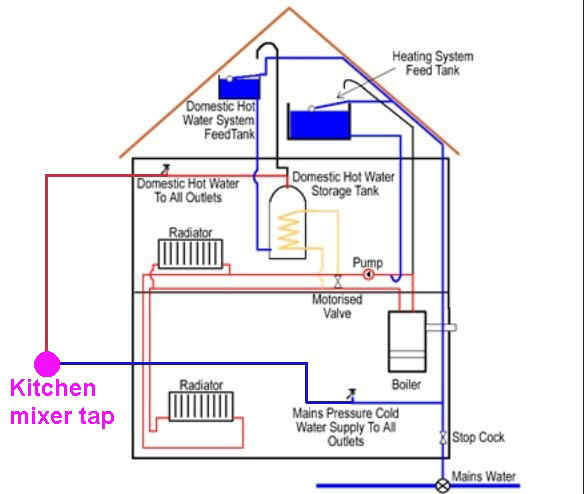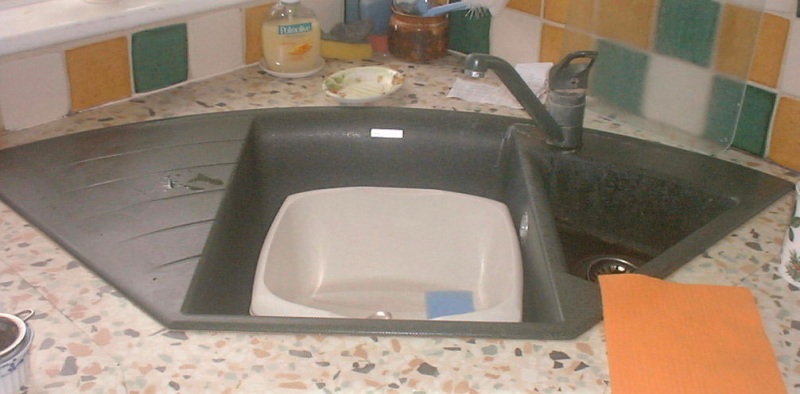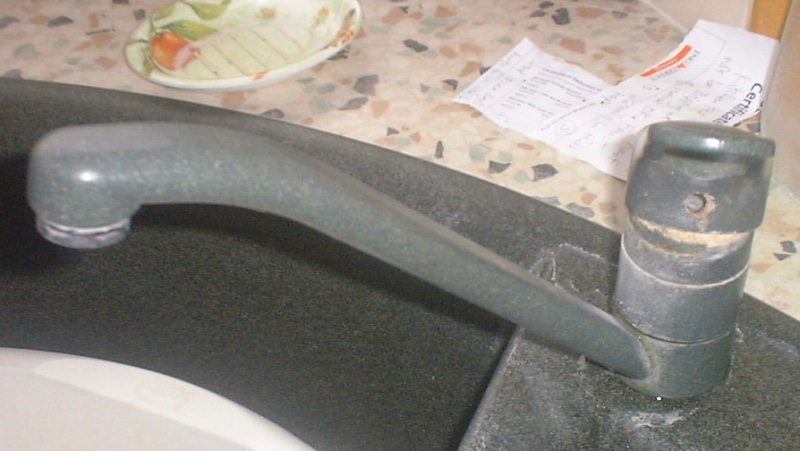An overflowing water cistern caused
by a faulty kitchen tap: a curious plumbing problem in a house in the UK!
This webpage might save you a lot of trouble if you have a
water cistern in the roof that occasionally overflows, and you can't figure out why.
We have a quaint system of plumbing in houses here in the
UK - stored water in a cistern in the roof space, a hot water tank (cylinder) somewhere in
the house fed by the cistern in the roof, and a coil inside the cylinder to heat it up.
Water from the boiler (furnace in the USA) passes through the coil.
When coils leak, as they sometimes do, water leaks from one
system to the other (boiler water into hot domestic water or vice-versa, often only when
the boiler is operating and the pipes are hot and stressed) and can overflow from the
cistern in the roof via a pipe that goes outdoors (if you are lucky and if it has been
installed correctly).
Usually, overflow from a warning pipe is simply caused by
failure of the ball float valve that controls the level in a water cistern, so when I was
asked to look at a friend's house that had an intermittent overflow, I simply replaced the
valve washers and then the nylon inserts - twice.
But occasionally there was still an overflow of water.

|
This is a typical diagram from the internet of
a hot water system in a UK house.There is one glaring error - the cold feed should never
go up the slope of the roof - it would be very subject to freezing! The overflow (warning)
pipes are not shown The domestic hot water system
cistern (incorrectly labelled a tank) is shown above the level of the heating system feed
cistern (tank) - and although this can be argued to be correct often the reverse is seen,
so any leak between the two systems feeds contaminated water containing antifreeze and
anti-corrosion chemicals into the hot water supply for the house.
Each cistern will have an overflow (warning) pipe going to outdoors, and often these are
again installed so that if an overflow occurs in very cold weather the water trickling
through the pipe freezes solid and thus the pipe becomes blocked - and is then useless as
an overflow. This is a very common design fault.
However, the only relevant point for the present discussion
is that a kitchen mixer tap is typically connected as shown - with high pressure cold
water on one side and low pressure hot water on the other. |
When water overflows from a cistern yet the ball float
valve in that cistern is not passing water the usual fault is a leak within the hot water
cylinder - this is usually the only point where the two systems can be connected.
I was just about to strip out and replace the cylinder (a
substantial job, maybe £300 or $500 even doing the work myself) when I noticed that a
pipe was slightly warm when it should have had cold water coming down from the roof. Also,
the water meter serving the house was turning around very slowly yet neither of the ball
float valves were passing any water.
Once in the roof again, this time with with a powerful
torch (inspection lamp) I noticed 'swirls' of warm water entering the base of the storage
cistern in the roof from the pipe whose job it was to feed cold water down to the
cylinder. This warm water was a different density - hence you could 'see' the tiny swirls.
This is often a sign of a failed coil - but I already knew the smaller cistern feeding the
boiler system was not gaining any water via it's own ball float valve, so where was this
water coming from?
It took a few minutes to figure out. The kitchen tap was
the cause of the problem. Cold water under high pressure (maybe 50psi) was leaking into
the hot side of the tap (low pressure, just the head of water from the cistern), backing
up the pipe from the kitchen into the cylinder, which in turn backed up into the cistern
in the roof, which then overflowed down the outside of the house - but only if left for 8
or 12 hours with no hot water being used in the house - so the level in the cistern
gradually rose to that of the overflow. Most of the time, often for many days, there was
no problem.
 |
The Schock kitchen mixer tap was about 15
years old and colour matched to the 'ceramic' sink.
A direct replacement was not obtainable, so a chrome unit had to be installed |
 |
Typically, the tap had a few external leaks.
Scale from hard water had disfigured it to some extent.
The next page shows photos of the cartridge inside the tap - and the cause of all the
intermittent overflow problems from inside the roof over many weeks! |
One of the photos from the next webpage was selected for
inclusion on an amazing
website based the USA - it contains a wealth of information and history about plumbing
products and other aspects of building.
Detailed photos of the failed mixer tap
Home page.
